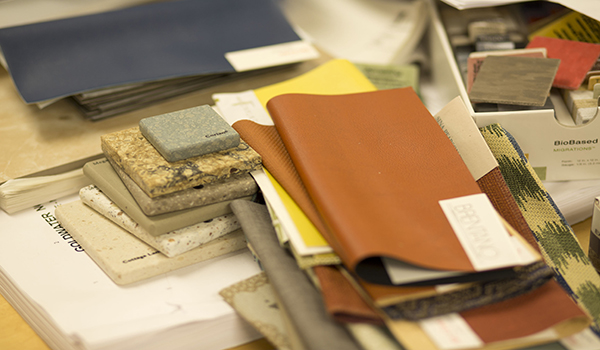As designers, we have a tendency to hold on to everything “just in case” we need it. The fast paced profession we live in has taught us to always have options on hand. However, it has become necessary to downsize our spaces in favor of going digital and the time has finally come for the Resource Library to follow suit.This may cause many of you to think you are on an episode of ‘Hoarders,’ but trust me you are not alone.
As we at Array started the journey toward digitizing, the first thing we had to assess was what we really needed versus wanted. For the most part, our Libraries are filled with outdated information, lost in the masses and miles of products that no one really uses. Now that everyone, including manufacturers, have gone digital with their literature, the need for physical binders of printed materials has disappeared.
Once we narrowed down the Library to necessary information, it was time to contact all the reps to come and collect their materials. Although you may struggle with making the calls, candidly; most of the reps are not surprised or taken aback. Most firms located in major cities have small libraries, so this is not new to them. The key in this step is to make sure you set a time frame! Anything left over after the deadline is getting recycled, which brings me to my next point. RECYCLE! We had tons of fabrics, wallcoverings, carpet and tile samples and instead of just trashing them we donated as much as possible. Look for local charities that are in need of art supplies, etc. for their programs. At Array, we donated our fabric samples to a local nursing home that will use the swatches in their craft room to create walker and wheelchair bags. We donated carpet tiles to the ballet company for use in their set-building shop. Now that’s upcycling at its best.
Now that you have downsized your Library, it’s time for the digitization process. You will need to decide what software is best for your company. We used our existing Deltek Vision software database and updated all contacts and companies. Most importantly, you need to decide what information you need to have available for indexing. We created new tabs that were geared specifically toward keeping the resource library organized. Things like specification section, sustainable attributes and BIM capabilities are some of the searchable features we included. Once that was complete, we created a searchable index through our social intranet, a product called Synthesis by Knowledge Architecture, that allows the entire firm to access the information and compare it all from one place. Because Synthesis performs in a similar fashion as social networking sites, staff can also share information pertaining to specific manufacturers in a live stream format in addition to uploading documents such as price lists. Designers can also share actual real-time project experience, both good and bad, so that others may use to inform their selection process. Using hashtags allows designers to search across a product type, for example: #moisture, can yield comments across many resilient flooring options. This is particularly useful in sharing anecdotal information across our multiple offices.
When indexing, be cautious not to duplicate information the manufacturer is already providing. Linking to price lists and documentation on a manufacturer website is always the easiest way to go. That eliminates anyone in your company being responsible for updating it, ensuring it’s always current - the manufacturer will do it for you! Linking to sites such as Sweets catalogs and Arcat are great supplements to your library. Why recreate something that has already been done by someone else? Your Library is a great starting point for knowing who to contact for information and how; let the true online databases do the legwork, the rest of it for you. A happy by-product is having increased display capacity for the materials and samples that provide daily inspiration. We now display a curated cross-section of fabric, glass, wood and stone samples that used to be tucked away in bins.
At Array, where long-term, multiple projects with one client are a core part of our business, we continually look to leverage technology to our clients’ advantage while ensuring quality in the selection and specification process. Our clients count on us to immerse ourselves in, and maintain real-time records of their particular product preferences as well as products they don’t like.
For Array, the effect of having such a dynamic library is the ability to customize it with regard to types of healthcare projects as well as specific clients. Manufacturers and products can be tagged as a part of the standards program for a specific hospital, making the process of maintaining client information easier and immediately availability to the entire company. Products can also be cataloged by their use group. For instance, at Array we have an extensive behavioral health catalog that references both finishes and furniture appropriate in all types of high-risk applications. By creating filters and hashtags, designers are able to quickly access this database and share that information with clients and consultants.
When all is said and done, your library really needs to suit your company and the way it functions. There is no one way to do it. Lose the clutter, organize and reap the benefits of a more comprehensive digital resource.


